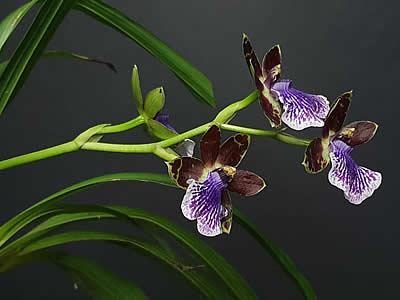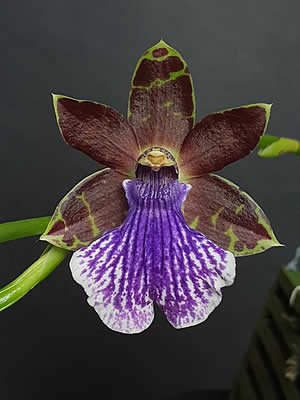The Spotted Zygopetalum (Zygopetalum maculatum) is a natural, sympodial, epiphytic orchid originating from Peru, Bolivia, and Brazil, including the states of Rio Grande do Sul, Santa Catarina, Paraná, São Paulo, Minas Gerais, Rio de Janeiro, Espírito Santo, Bahia, and Tocantins. It can be found in various biomes such as Caatinga, Cerrado, and Atlantic Forest. It prefers flat, very humid areas covered in moss, semi-swampy, at altitudes of up to 7,382 feet (2.250 metros).
It also appears in rocky and iron-rich fields, as well as forested areas in Minas Gerais. The genus name “Zygopetalum” is a Latinization of the Greek words Zygón = yoke + pétalon = petal, alluding to the thick callus at the base of the lip that gives the impression of pulling the floral pieces together. The species name “maculatum” means spotted, due to the marks on the petals and sepals.

It blooms in spring and summer, producing a racemose inflorescence, 15.75 inches (40 cm) in length, carrying 8 to 12 flowers. The flowers measure 1.57 to 3.15 inches (4 a 8 cm) in length, are fragrant, and last for about 45 days. They have green petals and sepals with brown-red spots and a white lip marked with violet stripes. Despite being essentially epiphytic, it is not uncommon to find this species growing as a lithophyte or terrestrial plant.
The Spotted Zygopetalum tolerates temperature variations between 37.4 to 95°F (3 a 35º C), However, if subjected to very high temperatures for extended periods, the buds may die. On the other hand, very low temperatures for prolonged periods can cause leaf drop, although it does not go dormant. It prefers 70% shading (with a light intensity of about 24,000 lux), relative humidity above 65%, and good ventilation.
On hot days, it should be sprayed with water to increase humidity. It does not tolerate dry substrate for more than 20 hours, as it is harmful to the health of the roots and leaves (the tips dry out and dry spots appear). It requires a lot of water and prefers constantly moist but not waterlogged conditions, so good substrate drainage should be allowed, but without drying out completely. In hot and sunny climates, the orchid should be watered well, as the plant’s metabolism accelerates, consuming water. Without watering, water will be drawn from the pseudobulbs and older leaves, causing the plant to wilt.

Cultivate the Spotted Zygopetalum in cachepots of the wood basket type, with a potting mix composed of equal parts of pine (or macadamia) bark, peat, expanded clay, and sphagnum moss. Fertilize every two weeks to prevent salinization. A recommended suggestion is to foliar feed (in spring and summer) with a solution of 0.07 ounces (2g or 1/3 teaspoon) of NPK Peter’s 20-20-20 fertilizer per quart of water. In the surface of substrate, you can sprinkle a monthly with an orchid organic fertilizer like bokashi. In winter, it is interesting to provide a fertilizer with a high phosphorus content (NPK 9-45-15).


